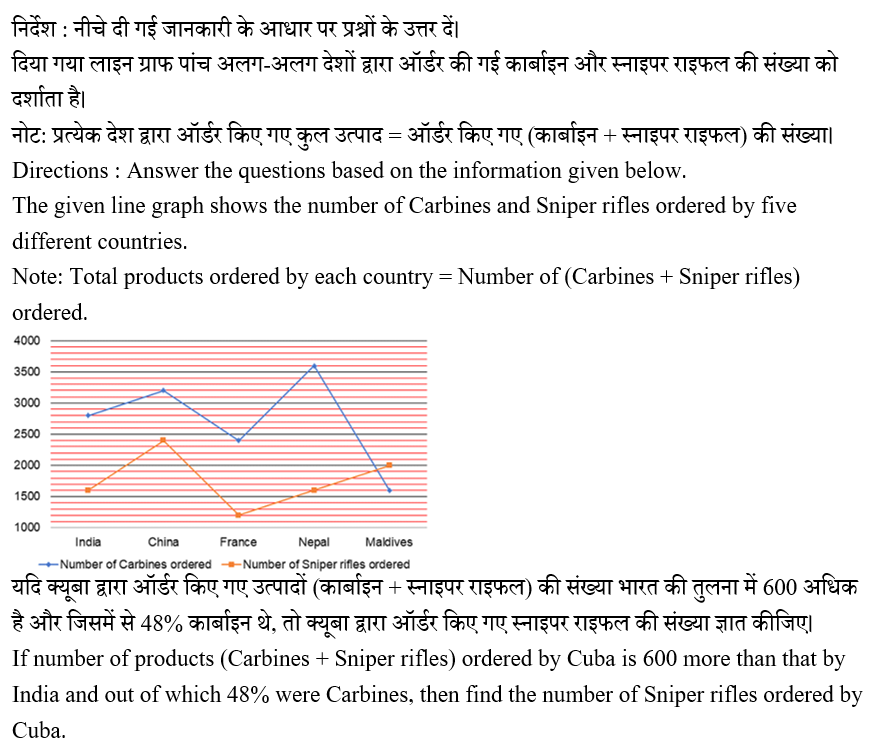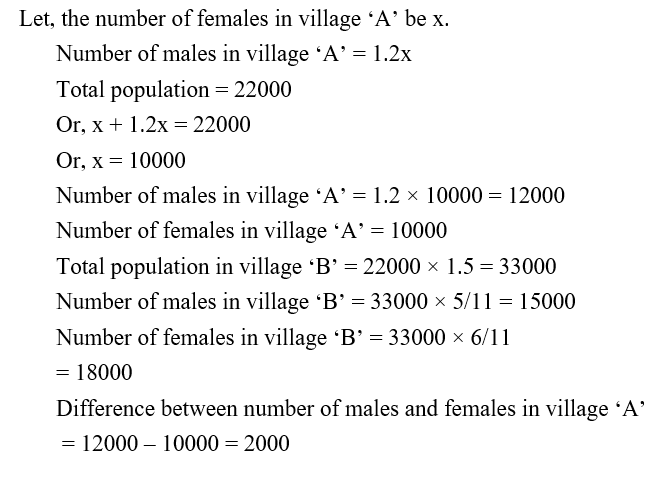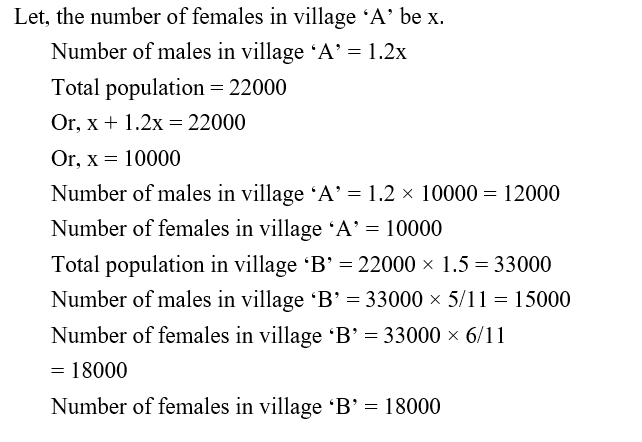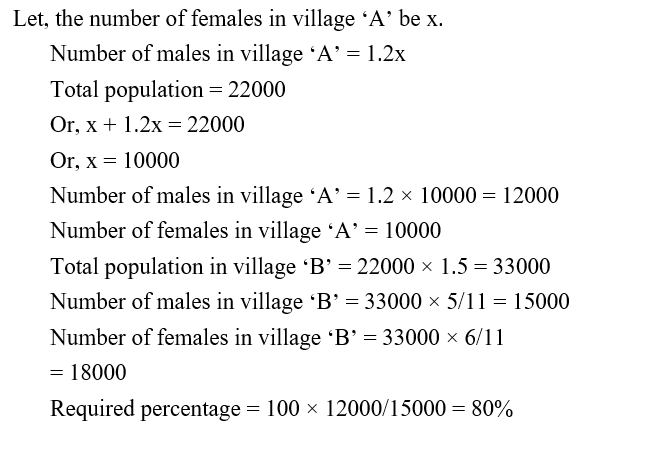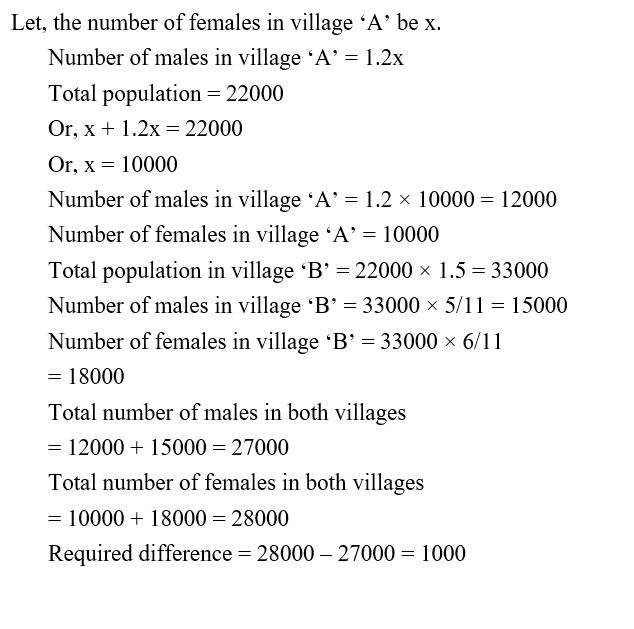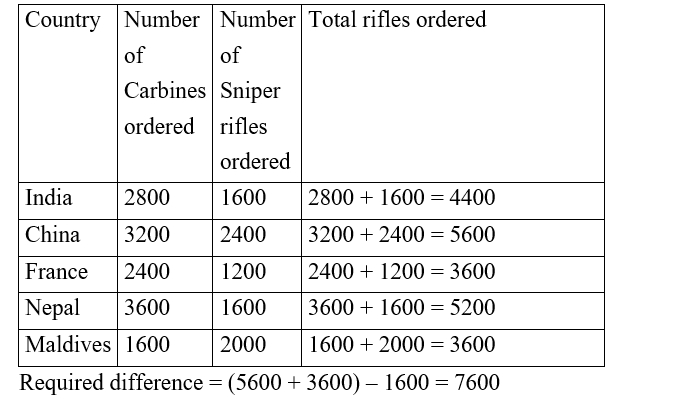Question 1:
निर्देश : नीचे दी गई जानकारी के आधार पर प्रश्नों के उत्तर दें।
एक जिले में 2 गांव (गांव A और गांव B) हैं। गांव 'A' की कुल जनसंख्या 22000 है। गांव ‘A’ में पुरुषों की संख्या गांव ‘A’ में महिलाओं की संख्या से 20% अधिक है। गाँव 'B' की कुल जनसंख्या, गाँव 'A' की कुल जनसंख्या से 50% अधिक है। गाँव 'B' में पुरुषों की संख्या और महिलाओं की संख्या का अनुपात 5:6 है।
Directions : Answer the questions based on the information given below.
There are 2 villages (village A and village B) in a district. Total population of village ‘A’ is 22000. Number of males in village ‘A’ is 20% more than the number of females in village ‘A’. Total population of village ‘B’ is 50% more than total population of village ‘A’. Ratio of number of males to number of females. The ratio of the number of males to the number of females in village 'B' is 5:6.
गाँव 'A' में पुरुषों की संख्या और महिलाओं की संख्या के बीच का अंतर ज्ञात कीजिए।
Find the difference between number of males and number of females in village ‘A’.
Question 2:
निर्देश : नीचे दी गई जानकारी के आधार पर प्रश्नों के उत्तर दें।
एक जिले में 2 गांव (गांव A और गांव B) हैं। गांव 'A' की कुल जनसंख्या 22000 है। गांव ‘A’ में पुरुषों की संख्या गांव ‘A’ में महिलाओं की संख्या से 20% अधिक है। गाँव 'B' की कुल जनसंख्या, गाँव 'A' की कुल जनसंख्या से 50% अधिक है। गाँव 'B' में पुरुषों की संख्या और महिलाओं की संख्या का अनुपात 5:6 है।
Directions : Answer the questions based on the information given below.
There are 2 villages (village A and village B) in a district. Total population of village ‘A’ is 22000. Number of males in village ‘A’ is 20% more than the number of females in village ‘A’. Total population of village ‘B’ is 50% more than total population of village ‘A’. Ratio of number of males to number of females. The ratio of the number of males to the number of females in village 'B' is 5:6.
गाँव 'B' में महिलाओं की संख्या ज्ञात कीजिए।
Find the number of females in village ‘B’.
Question 3:
निर्देश : नीचे दी गई जानकारी के आधार पर प्रश्नों के उत्तर दें।
एक जिले में 2 गांव (गांव A और गांव B) हैं। गांव 'A' की कुल जनसंख्या 22000 है। गांव ‘A’ में पुरुषों की संख्या गांव ‘A’ में महिलाओं की संख्या से 20% अधिक है। गाँव 'B' की कुल जनसंख्या, गाँव 'A' की कुल जनसंख्या से 50% अधिक है। गाँव 'B' में पुरुषों की संख्या और महिलाओं की संख्या का अनुपात 5:6 है।
Directions : Answer the questions based on the information given below.
There are 2 villages (village A and village B) in a district. Total population of village ‘A’ is 22000. Number of males in village ‘A’ is 20% more than the number of females in village ‘A’. Total population of village ‘B’ is 50% more than total population of village ‘A’. Ratio of number of males to number of females. The ratio of the number of males to the number of females in village 'B' is 5:6.
गांव 'A' में पुरुषों की संख्या गांव 'B' में पुरुषों की संख्या का कितना प्रतिशत है?
Number of males in village ‘A’ is what percentage of the number of males in village ‘B’?
Question 4:
निर्देश : नीचे दी गई जानकारी के आधार पर प्रश्नों के उत्तर दें।
एक जिले में 2 गांव (गांव A और गांव B) हैं। गांव 'A' की कुल जनसंख्या 22000 है। गांव ‘A’ में पुरुषों की संख्या गांव ‘A’ में महिलाओं की संख्या से 20% अधिक है। गाँव 'B' की कुल जनसंख्या, गाँव 'A' की कुल जनसंख्या से 50% अधिक है। गाँव 'B' में पुरुषों की संख्या और महिलाओं की संख्या का अनुपात 5:6 है।
Directions : Answer the questions based on the information given below.
There are 2 villages (village A and village B) in a district. Total population of village ‘A’ is 22000. Number of males in village ‘A’ is 20% more than the number of females in village ‘A’. Total population of village ‘B’ is 50% more than total population of village ‘A’. Ratio of number of males to number of females. The ratio of the number of males to the number of females in village 'B' is 5:6.
गांव ‘A’ और ‘B’ में महिलाओं की कुल संख्या दोनों गांवों की कुल जनसंख्या का (लगभग) कितना प्रतिशत है?
Number of females in villages ‘A’ and ‘B’ together is what percentage (approximately) of the total population of both villages?
Question 5:
निर्देश : नीचे दी गई जानकारी के आधार पर प्रश्नों के उत्तर दें।
एक जिले में 2 गांव (गांव A और गांव B) हैं। गांव 'A' की कुल जनसंख्या 22000 है। गांव ‘A’ में पुरुषों की संख्या गांव ‘A’ में महिलाओं की संख्या से 20% अधिक है। गाँव 'B' की कुल जनसंख्या, गाँव 'A' की कुल जनसंख्या से 50% अधिक है। गाँव 'B' में पुरुषों की संख्या और महिलाओं की संख्या का अनुपात 5:6 है।
Directions : Answer the questions based on the information given below.
There are 2 villages (village A and village B) in a district. Total population of village ‘A’ is 22000. Number of males in village ‘A’ is 20% more than the number of females in village ‘A’. Total population of village ‘B’ is 50% more than total population of village ‘A’. Ratio of number of males to number of females. The ratio of the number of males to the number of females in village 'B' is 5:6.
दोनों गांवों में महिलाओं और पुरुषों की कुल संख्या का अंतर कितना है?
What is the difference of total number of females and males in both villages?
Question 6: 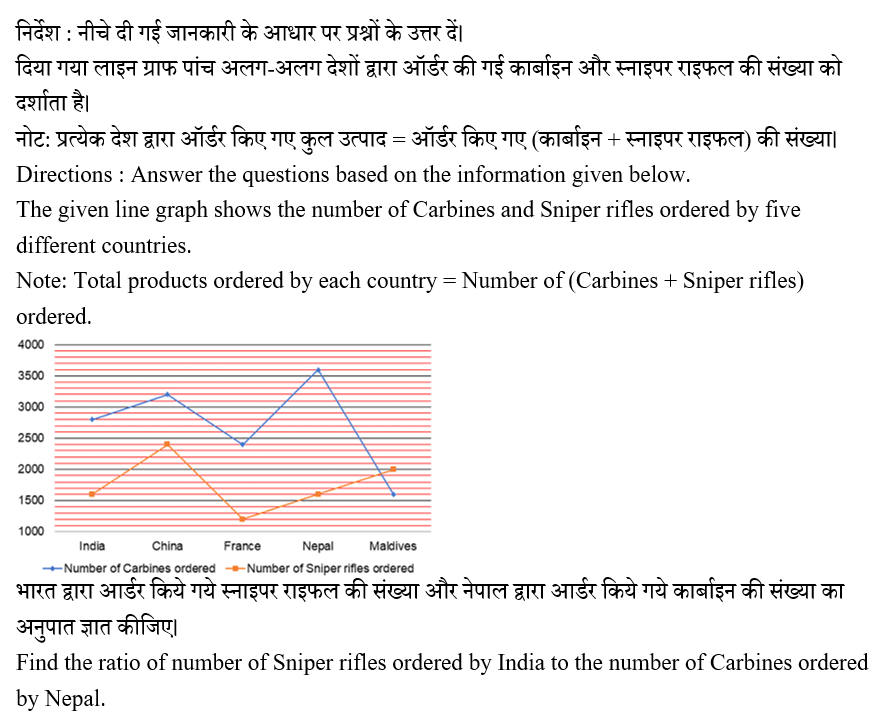
Question 7: 
Question 8: 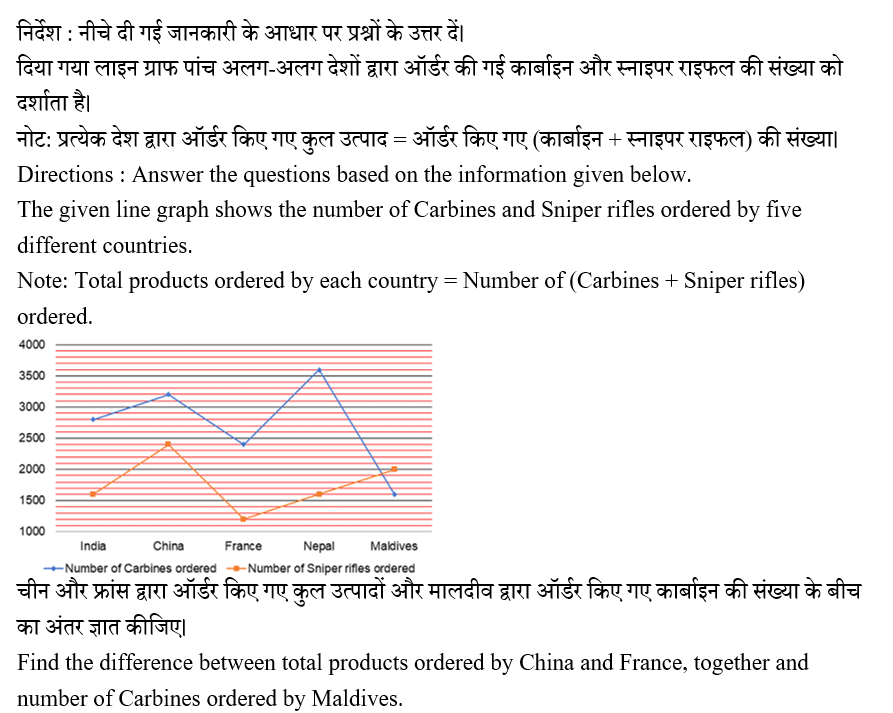
Question 9: 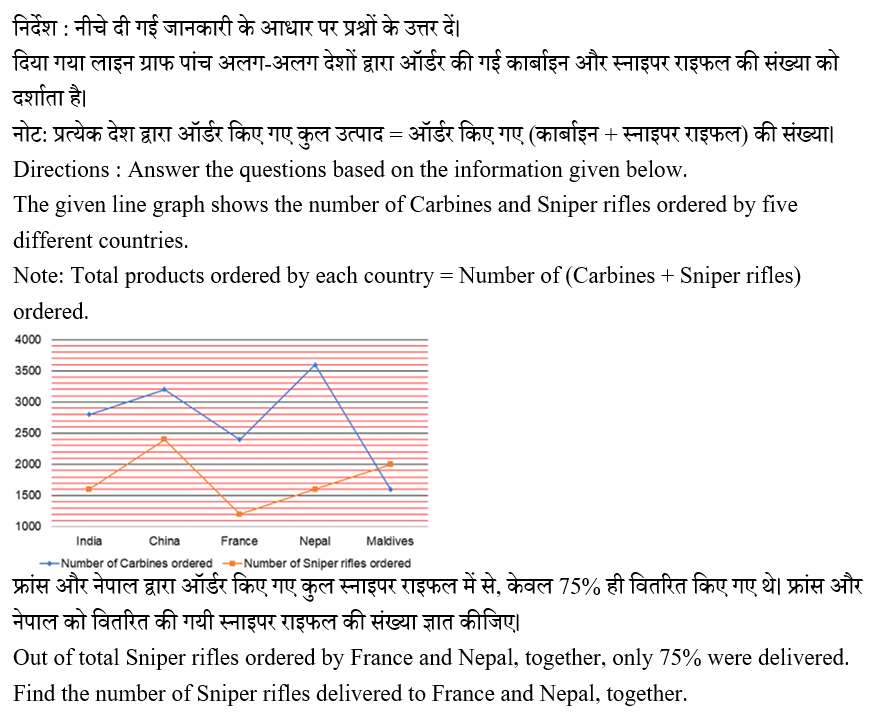
Question 10: 